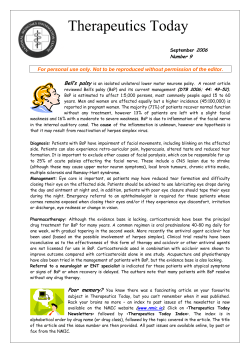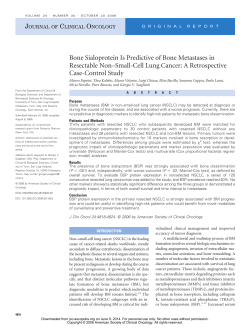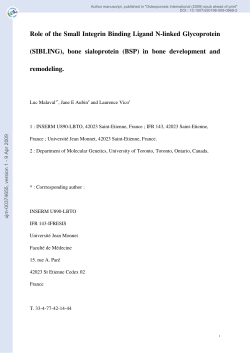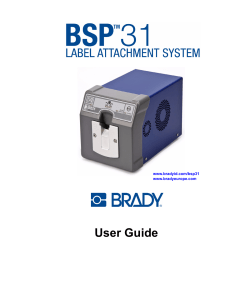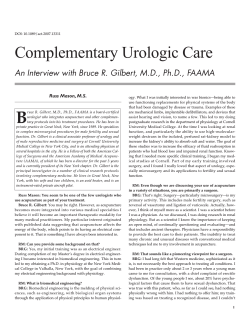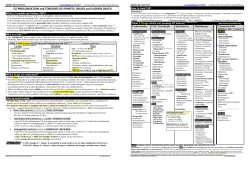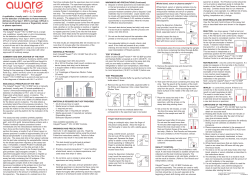
Binding patterns of bovine seminal plasma proteins A1/A2, 30 kDa... 1 ejaculated sperm before and after incubation with isthmic and ampullary...
1 Binding patterns of bovine seminal plasma proteins A1/A2, 30 kDa and osteopontin on 2 ejaculated sperm before and after incubation with isthmic and ampullary oviductal fluid 3 Carlos Eduardo A. Souza 1 , Arlindo A. Moura, Elisa Monacao, Gary J. Killian 4 5 6 (accepted – September 2007 – Animal Reproduction Science) 7 8 Almquist Research Center, Department of Dairy and Animal Science, Pennsylvania State 9 University, USA 10 11 This research was funded by USDA grants 2003-34437-13460 and 2004-34437-15106. 12 1 13 (CAPES). Supported by a graduate student fellowship awarded by the Brazilian Research Council 14 15 Key words: BSP proteins, fertility, oocyte, osteopontin, oviductal fluid, sperm. 16 17 18 19 20 21 22 23 24 25 26 27 28 29 30 Corresponding authors: Arlindo A. Moura Department of Animal Science Federal University of Ceara Av. Mister Hull, s/n Campus do Pici Fortaleza CE Brazil 60021 Phone: 85-3366-9697 Email: arlindo.moura@gmail.com Gary J. Killian Almquist Research Center Penn State University University Park, PA 16802 Phone: 814-329-0009 Email: garykillian@gmail.com 1 31 Abstract 32 Previous studies from our laboratory have reported empirical associations between bovine 33 seminal plasma (BSP) proteins A1/A2 and 30 kDa and osteopontin (OPN) in accessory sex gland 34 fluid and bull fertility. These BSPs and OPN are believed to bind to sperm at ejaculation and to 35 remain bound until sperm reach the oviduct. The objective of this study was to evaluate the 36 topographical distribution of BSP A1/A2, 30 kDa and OPN binding on: 1. bovine ejaculated 37 sperm; 2. ejaculated sperm incubated with isthmic oviductal fluid (ODF); 3. ejaculated sperm + 38 isthmic ODF incubated in ampullary ODF. From each of those media, we processed aliquots of 39 sperm for BSPs and OPN immunocytochemistry and analysis by laser scanning confocal 40 microscopy. Isthmic and ampullary ODF was collected from indwelling catheters and used as 41 pools from three cows in the non- luteal phase of the estrus cycle. Anti- BSP A1/A2 was detected 42 bound to the midpiece, post-equatorial and equatorial segments and acrosome of sperm after 43 ejaculation and after incubation with isthmic and ampullary ODF. BSP A1/A2 fluorescence was 44 significantly more concentrated on the midpiece and increased as acrosome- intact sperm became 45 in contact with ODF. As compared with acrosome- intact sperm, non- intact acrosome intact 46 sperm had 39 and 68 % reductions of acrosome fluorescence and 36 and 90 % increases of post- 47 equatorial fluorescence after contact with isthmic and ampullary ODF (p < 0.05). Anti-BSP 30 48 kDa was more intense on the midpiece than on post-equatorial, equatorial and acrosome regions 49 of sperm after ejaculation and contact with ODF. However, equatorial fluorescence was 141 and 50 89 % more intense and acrosome stainning was 80 and 76 % lower (p < 0.05) in non- intact 51 acrosome sperm than in acrosome intact cells, during all ODF incubations. Anti-OPN was 52 identified on the acrosome of ejaculated sperm, but with less fluorescence (p < 0.05) on the post- 53 equatorial segment and midpiece. Incubation of sperm with isthmic ODF increased fluorescence 2 54 on post-equatorial segment (p < 0.05). There were 72 and 78 % reductions (p < 0.05) of 55 acrosome fluorescence and intensification (p < 0.05) in equatorial fluorescence in non- intact 56 acrosome sperm as compared with acrosome intact cells incubated with isthmic and ampullary 57 ODF. In summary, interactions of BSP A1/A2 and 30 kDa and osteopontin with the sperm 58 membrane undergo modifications dictated by the oviductal fluid. BSPs are thought to modulate 59 cholesterol and phospholipid movement from the sperm membrane and help sperm binding to 60 the oviductal epithelium. Furthermore, our model suggests that OPN participates in sperm- 61 oocyte interaction, affecting fertilization and early embryonic development. 3 62 Introduction 63 64 Previous studies from our laboratory have reported empirical associations between proteins in 65 male reproductive fluids and fertility of high use, proven dairy bulls. These associations were 66 derived from the phenotype of reproductively normal bulls with fertility scores calculated from 67 thousands of inseminations. Fertility scores of bulls were positive ly correlated with amounts 68 osteopontin and phospholipase A2 in seminal plasma, negative ly correlated with spermadhesin 69 Z13 and showed a quadratic association with bovine seminal plasma protein (BSP) 30 kDa 70 (Killian et al., 1993; Moura et al., 2006a). Moreover, accessory sex gland fluid containing more 71 albumin, BSP A1/A2, BSP 30 kDa, clusterin, osteopontin and phospholipase A2 , and less 72 nucleobindin, was more likely to enhance oocyte-penetrating capacity of cauda epididymal 73 sperm than fluid with opposite characteristics (Moura et al., 2006b). From these studies it was 74 clear that seminal plasma and accessory sex gland fluid contain protein markers of male fertility. 75 Both in vivo and in vitro studies have indicated that bovine seminal plasma (BSP) proteins 76 and osteopontin (OPN) were among accessory sex gland proteins related to bull fertility. BSP 77 proteins comprise approximately 86 % of all proteins detected in the bovine accessory sex gland 78 fluid (Moura et al., 2006c) and are known to induce phospholipid and cholesterol efflux from the 79 sperm membrane (Manjunath and Thérien, 2002). In vitro studies indicate that BSP proteins 80 mediate sperm binding to the oviduct epithelium and maintain sperm motility in that region of 81 the female reproductive tract (Gwathmey et al., 2003, 2006). Osteopontin (OPN) expression is 82 the most significant marker of fertility in dairy bulls, being 4.5- fold more abundant in the 83 accessory sex gland fluid of sires with the highest fertility scores (Killian et al., 1993; Moura et 84 al., 2006a). OPN has been detected in several types of tissues, including extracellular matrix of 4 85 bones (Franzen and Heinegard, 1985) mammary gland, endothelial cells, macrophages, tumor 86 cells, follicles, corpus luteum and trophoblasts (for review: Mazzali et al., 2002; Johnson et al., 87 2003; Denhardt, 2004; Rangaswami et al., 2006). OPN has been reported to function in cell 88 adhesion and cell- extracellular matrix communication, stimulation of immune cells, tissue 89 mineralization, cell migration and prevention of apoptosis (see reviews above). Because OPN is 90 a cell adhesion molecule, it was hypothesized that OPN functions in sperm-oocyte interaction 91 and fertilization (Moura, 2005), which has recently been supported by in vitro fertilization 92 studies with bovine (Goncalves et al., 2006a) and porcine gametes ( Hao et al., 2006). Accessory 93 sex gland proteins such as osteopontin and BSP are believed to bind to sperm at ejaculation and 94 are assumed to remain bound until sperm reach the site of fertilization. 95 Information on the localization of fertility-related proteins of accessory sex gland origin on 96 ejaculated sperm and how they may be modified following exposure to oviductal secretions may 97 provide insights into their role in male fertility. The objective of this immunocytochemical study 98 was to evaluate the topographical distribution and protein intensity of BSP A1/A2, BSP 30 kDa 99 and osteopontin on ejaculated sperm before and after in vitro incubation with isthmic and 100 ampullary oviductal fluids. 101 102 Material and Methods 103 104 105 Experimental design Binding patterns of fertility-associated proteins BSP A1/A2, BSP 30 kDa and osteopontin 106 were evaluated in sperm collected from fresh semen and after sperm became sequencially 107 exposed to fluid of isthmus and ampulla oviduct. The experiment used sperm from five Holstein 5 108 bulls and conducted analysis with sperm in the following conditions : 1. ejaculated sperm; 2. 109 ejaculated sperm incubated with isthmic oviductal fluid; 3. ejaculated sperm + isthmic oviductal 110 fluid (as in 2) incubated in ampullary oviductal fluid. From each of those media (1, 2 and 3), we 111 processed aliquots of sperm for immunocytochemistry and analysis by laser scanning confocal 112 microscopy. 113 114 115 Collection of oviductal fluid Fluid from isthmic and ampullary oviducts was collected from indwelling catheters inserted 116 in the same cow, as previously described (Kavanaugh et al., 1992). After collection, fluid was 117 centrifuged at 10,000 g for 1 hour at 4 o C and stored in liquid nitrogen until use. Oviductal fluid 118 and blood samples were obtained during at least two consecutive full estrous cycles and 119 peripheral concentrations of progesterone determined by radioimmunoassay. Non- luteal 120 oviductal fluid from days of the estrous cycle when serum progesterone was less than 1 ng/ml 121 were pooled for each cow. For all sperm incubations non-luteal pooled samples of fluid from 122 each oviduct region were combined from three different cows. 123 124 Sperm preparation and incubation with oviductal fluid 125 After collection by artificial vagina, semen was kept in a water bath at 37 o C for 10 minutes, 126 and then centrifuged (700g for 15 min) to recover sperm from seminal plasma. Sperm were then 127 washed by two additional centrifugations with modified Tyrode’s medium (MTM). Aliquots of 5 128 x 106 cells were processed for immunocytochemistry using polyclonal antibodies against BSP 129 A1/A2, BSP 30 kDa and osteopontin. From the remaining sperm, 50 x 106 cells were taken and 130 incubated for 4 hours (39 o C, 5 % CO2 ) in a media containing isthmic oviductal fluid (50 %, v/v), 6 131 MTM containing pyruvate (1 mM) penicillin (100 UI/ml) and streptomycin (100 µg/ml) (Sigma 132 Inc., St. Louis, MO, USA). Following oviduct fluid incubation, aliquots of 5 x 106 cells were 133 removed for immunocytochemistry as indicated above and the remaining pool of sperm 134 incubated in ampullary oviductal fluid/MTM (50 %, v/v) for 1 hour (39 o C, 5 % CO2 ). After 135 incubation, aliquots of 5 x 106 cells were taken again for immunocytochemistry. Using a laser 136 scanning confocal microscopy (Olympus Inc., Center Valley, PA, USA), we examined ten cells 137 per animal, per treatment at a magnification of 1,000 x and digital zoom of 5x. 138 After each incubation, an aliquot of 100 µl was exposed for 10 minutes (39°C) to 60 µg/mL 139 of lysophosphotidylcholine (LPC) containing 50 µg/µl of bovine serum albumin (BSA) to induce 140 acrosome reaction in capacitated sperm (Parrish et al., 1988). After treatment with LPC, an 141 aliquot of 10 µl was then mixed with equal volume of staining solution (Fast Green FCF-Eosin 142 B) and 100 cells per treatment per animal were evaluated by light microscopy. We consider 143 capacitated those live sperm and with reacted acrosome, in response to LPC. 144 145 146 Immunocytochemistry Sperm samples collected before and after incubation with isthmic and ampullary oviductal 147 fluid were fixed in paraformaldehyde (2%) for 10 minutes and washed twice thereafter in PBS 148 using gentle centrifugation (500 xg, 5 min., 4 o C). Blocking of nonspecific binding followed with 149 a 2-hour incubation in PBS-Tween 20 containing 5 % of bovine serum albumin (BSA), under 150 mild agitation at 4°C. Sperm were again incubated in blocking solution with the primary 151 antibodies (1:200 for anti-BSP A1/A2 or BSP 30 kDa and 1:100 for anti-osteopontin) for 2 hours 152 under gentle agitation (4 o C) and washed three times thereafter with PBS-Tween 20 (500 xg; 5 153 min.). Sperm were then incubated with anti-IgG conjugated with FITC (1:300; Sigma Inc., St 7 154 Louis, MI, USA) for 1 hour in a solution of PBS-Tween 20 and BSA (1 %), followed by three 155 washes. Slides were mounted in the dark using antifade reagent (Invitroge n Corp., Carlsbad, CA, 156 USA). 157 Antibodies against BSP A1/A2 and 30 kDa were purified from respective rabbit antisera 158 kindly provided by Dr. Puttaswamy Manjunath (Department of Medicine, University of 159 Montreal, Canada). As described before (Moura et al., 2007), a column with protein-A Sepharose 160 matrice (Sepharose CL-4B; Sigma Co., St. Loius, MO, USA) was washed initially with 50 nM 161 PBS containing 0.15 M NaCl (pH 7.4) and adsorbed proteins were eluted with Glycine-HCl (pH 162 2.5). Fractions with absorbance at 280 nm were pooled, which contained the anti-BSP 163 antibodies, and immediately adjusted to pH 7.4 with 0.1 N NaOH. The antibody solution was 164 then aliquoted and stored in ? 20 ?C until use. For detection of osteopontin in sperm we used a 165 rabbit polyclonal antibody generated against OPN purified from bovine milk (Gabler et al., 166 2003). For all studies with immunocytochemistry, controls were conducted using incubations of 167 sperm cells with the first antibody only and with the second antibody only. None of theses 168 approaches generated any form of detectable fluorescence. 169 170 Capture of images and statistical analysis 171 Images of sperm treated with the first and FITC-conjugated antibodies were captured by 172 confocal microscopy and FluoViewT M software (Olympus Inc., Center Valley, PA, USA) as a 173 series of sequential planes taken at every 0.125µm, with a total depth of 5µm. Such images or 174 “stacks” were deconvoluted using AutoDeblur software (Media Cybernetics Inc., Silver Springs, 175 MD, USA) and intensit y of fluorescence quantified (in pixels) where staining was detected. 176 Average pixel intensity of all sequential planes taken from each cell were compared by Duncan 8 177 statistical test (SAS, 2003) among different regions of sperm, within and across three treatments 178 (1. ejaculated sperm; 2. ejaculated sperm plus isthmic oviductal fluid; 3. ejaculated sperm plus 179 isthmic oviductal fluid plus ampullary oviductal fluid). Based on preliminary analysis of images 180 representing binding of all antibodies (against BSP proteins and OPN), pixe l intensities were 181 quantified in the following regions of sperm: midpiece, pots-equatorial, equatorial and acrosome 182 (Fig. 1). We separately analyzed cells with intact acrosome and non- intact acrosome. 9 183 Results 184 185 The antibody against BSP A1/A2 was detected bound to the midpiece, post-equatorial and 186 equatorial segments and acrosome of sperm after ejaculation and after incubation with non-luteal 187 isthmic and ampullary oviductal fluid (Fig. 2). Analysis of different planes from several cells 188 shows fluorescence significantly more concentrated on the entire midpiece than on the other 189 regions (Fig. 3), in all conditions sperm cells were subjected to. However, binding intensity of 190 anti-BSP A1/A2 on the midpiece of acrosome- intact sperm increased as cells became in contact 191 with oviductal fluids, while immunoreactivity on the other regions remained unchanged (Fig. 3). 192 Cells with non- intact acrosome showed the same topographical distribution of anti-BSP A1/A2 193 binding on midpiece, post-equatorial and equatorial regions. As compared with acrosome-intact 194 sperm, non- intact acrosome intact sperm had 39 and 68 % reductions of acrosome fluorescence 195 and 36 and 90 % increases of post-equatorial fluorescence after contac with isthmic and 196 ampullary oviductal fluid, respectively (p < 0.05; Fig. 3). 197 Anti-BSP 30 kDa reaction appeared more intense on the midpiece than on post-equatorial, 198 equatorial and acrosome regions of sperm evaluated after ejaculation and contact with isthmic 199 and ampullary oviductal fluid (Figs. 4 and 5). However, equatorial fluorescence was 141 and 89 200 % more intense (p < 0.05) in non- intact acrosome sperm than in acrosome intact cells, during 201 both isthmic and ampullary ODF incubations, respectively. Acrosome fluorescence, in turn, was 202 80 and 76 % less prominent (p < 0.05) in non- intact acrosome sperm than in acrosome intact 203 cells, at the same conditions (Fig. 5). 204 205 Anti-osteopontin binding was primarily identified on the acrosomal cap of ejaculated sperm with less fluorescence (p < 0.05) on the post-equatorial segment and midpiece (Fig. 6 and 7). 10 206 Incubation of sperm with isthmic ODF for 4 hours increased the fluorescence on post-equatorial 207 segment (p < 0.05), but without alterations on the acrosomal cap or midpiece, in comparison with 208 the same regions on ejaculated sperm. Subsequent contact with ampullary fluid did not change 209 fluorescence on either midpiece, post-equatorial segment or acrosome (Fig. 7). Cells with non- 210 intact acrosome showed pronounced reductions (p < 0.05) of the fluorescence on the acrosome, 211 when compared with acrosome intact cells incubated in isthmic and ampullary oviductal fluid 212 (72 and 78 % reductions, respectively). Also, there was intensification (p < 0.05) in equatorial 213 fluorescence in non- intact acrosome sperm as compared with acrosome intact cells, in both 214 conditions. Antibody binding to the midpiece remained without significant changes (Fig. 7). 215 The highest percentage of spermatozoa undergoing capacitation and capable of acrosome 216 reaction when treated with LPC occurred aft er incubation with isthmic (39.8 and 79 %) and 217 ampullary oviductal fluid (20.5 and 69.3 %, respectively), in comparison with ejaculated 218 spermatozoa mixed with MTM only (12.3 and 49.3 %) or with heparin (23.7 and 38.9 %; Fig. 8). 11 219 Discussion 220 221 The present study shows detailed analysis of binding patterns of fertility-associated proteins 222 BSP A1/A2, BSP 30 kDa and osteopontin in ejaculated sperm and after sperm were exposed to 223 non- luteal isthmic and ampullary oviductal fluid. Because none of the antibodies against these 224 proteins showed detectable immunoreaction with bull sperm collected from the cauda 225 epididymidis (data not shown), it is clear that BSP proteins and osteopontin originate from the 226 accessory sex glands and bind to sperm at ejaculation. Manjunath et al. (1993) described some 227 immunoreactivity of anti-BSP 30 kDa with cauda epididymal sperm, but we were unable to 228 detect BSP proteins even when antibody concentrations were 50 % greater than those used in the 229 present study. Association of BSP proteins with membranes of the ejaculated sperm head is in 230 accord with experimental evidence that BSP proteins participate in cholesterol and phospholipid 231 removal from the membrane (Manjunath and Thérien, 2002). In this model, BSP proteins remain 232 bound to sperm as they traverse the female reproductive tract. After reaching the oviduct, 233 interaction of sperm-bound BSP proteins occur with HDL triggering a second cholesterol efflux 234 from the membrane which initiates capacitation. Studies also suggest that BSP proteins mediate 235 sperm binding to the oviductal epithelium, helping to preserve sperm viability and motility while 236 in the oviductal reservoir (Gwathmey et al., 2006). 237 The proposed role of BSP proteins in sperm capacitation assumes that they remain attached to 238 ejaculated sperm in the female reproductive tract. Our results monitoring BSP proteins of sperm 239 before and after incubation in oviductal fluids support this notion although changes in staining 240 intensity were observed. In non- intact acrosome sperm, BSP A1/A2 and BSP 30 kDa 241 fluorescence intensities significantly decreased in the acrosome region after sperm came in 12 242 contact with both isthmic and ampullary oviductal fluids. Such modifications may be the result 243 of fusion of the acrosome membrane caused by the acrosome reaction and/or rearrangements of 244 the sperm membrane triggered by movement of cholesterol and phospholipids, some of which 245 are modulated by BSP proteins. Oviductal fluids have the ability to induce acrosome reaction of 246 bovine sperm in vitro (Killian, 2004). ODF also contains apolipoprotein A-I and high density 247 lipoproteins, known to interact with both phospholipids and BSP proteins (Manjunath and 248 Thérien, 2002; Thérien et al., 1997). We have also determined that albumin comprises more than 249 85 % of all proteins detected in both isthmic and ampullary oviductal fluid (unpublished results). 250 Albumin is known to facilitate cholesterol efflux from membranes and may promote sperm 251 capacitation as well (Singleton and Killian, 1983; Go and Wolf, 1985; Visconti and Kopf, 1998). 252 Taken together with the current findings it appears that oviductal fluid creates an environment in 253 which direct or indirect modifications of the sperm membrane occur and result in altered staining 254 patterns of BSP proteins bound to the head and acrosome of ejaculated sperm. 255 The pronounced BSP protein immunofluorescence at the sperm midpiece, which was much 256 greater than in the other regions of the sperm at all treatments, is intriguing. Intense 257 immunoreaction of anti-BSP A1/A2 (Pdc 109) at the midpiece has been reported previously for 258 ejaculated bovine sperm (Aumuller et al., 1988). They suggested that localization of BSP 259 proteins in the midpiece close to the mitochondria may indicate that BSP proteins affect sperm 260 motility. Although protein receptors for BSP proteins have not been identified, it has been shown 261 that BSP A1/A2 stimulates sperm motility and membrane-bound calcium ATPase activity in 262 bovine sperm (Sanchez-Luengo et al., 2004). The functional connection between binding of BSP 263 proteins to the midpiece and stimulation of mitochondrial activity and sperm motility suggests 13 264 multifaceted role for BSP proteins as sperm are prepared for fertilization. Although it has not 265 been tested, BSP proteins may influence hyperactivation of sperm as well as sperm capacitation. 266 In the present study we observed an unexplained increase in fluorescence associated with BSP 267 A1/A2 binding to the midpiece of sperm after exposure to oviductal fluid. Based on earlier 268 reports (reviewed in Killian, 2004) and an analysis of ODF composition by 2-D electrophoresis 269 and mass spectrometry (Souza et al., 2007) there is no evidence that BSP proteins are expressed 270 in either isthmic and ampullary ODF. On the other hand, there were reductions in BSP A1/A2 271 fluorescence of the acrosome and increases in the post-equatorial segment of non-acrosome 272 intact sperm after incubations with oviductal fluids. Anti- BSP 30 kDa reaction also changed, as 273 equatorial fluorescence was more intense and acrosome fluorescence, in turn, less prominent in 274 non-acrosome intact sperm than in acrosome intact cells. One plausible explanation for the 275 changes in BSP protein binding to sperm exposed to ODF is that components of oviduct fluid 276 potentiate membrane remodeling and clustering of BSP proteins with the midpiece membrane. 277 Alternatively, components of ODF may remove or modify other surface proteins in specific 278 regions of sperm membrane and alter a quenching effect they may have had on FITC detection of 279 BSP poteins. 280 Anti-osteopontin binding was present on the post-equatorial segment and acrosomal cap of 281 ejaculated sperm, with less fluorescence on the midpiece. Incubation of sperm with isthmic ODF 282 increased the fluorescence on post-equatorial segment, but without alterations on the acrosoma l 283 cap or midpiece, in comparison with the same regions on ejaculated sperm, but subsequent 284 contact with ampullary fluid did not change fluorescence. These findings are intriguing and have 285 not been previously reported. Oviductal fluid contains OPN (Gabler et al. 2003) and it is possible 286 that such OPN binds to sperm, causing the increase in fluorescence seen in the post-equatorial 14 287 region. However, reductions on acrosome fluorescence and intensification in equatorial 288 fluorescence in non- intact acrosome sperm in the isthmic and ampullary ODF, as compared with 289 acrosome intact cells, are obviouslyy caused by other mechanisms. These changes may be the 290 consequence of membrane fusion and remodeling which occurs between the plasma and outer 291 acrosomal membranes prior to the acrosome reaction. Although coincidental increases in 292 acrosome reacted sperm (in response to LPC) occurred after incubation with oviductal fluids, the 293 theory that partial loss of acrosome OPN is a consequence of membrane remodeling awaits 294 further confirmation. Nevertheless, it seems that spermatozoa will reach the site of fertilization 295 with OPN steadily bound to the equaorial/post-equatorial region but varying degrees of OPN 296 attachment to the acrosomal cap. However, it remains to be determined if such different 297 populations of cells also have different fertilizing abilities. Moreover, link of OPN to the central 298 region of sperm is of special relevance because membrane fusion is thought to occur using the 299 segments close to the equatorial region of sperm (Gaddum-Rosse, 1985). 300 Osteopontin is a multifunctional molecule typically involved in cell adhesion and tissue 301 remodeling, but other events also occurs (for reviews see: Liaw et al., 1998; Mazzali et al., 2002; 302 Wai and Kuo, 2004; Denhardt, 2004). Despite substantial information about the actions of 303 osteopontin in several tissues, an understanding of its function in male reproduction is far from 304 complete. Based on general attributes of osteopontin and results from our earlier studies, we 305 hypothesized that OPN mediates sperm-oocyte interaction and fertilization (Moura, 2005; Moura 306 et al., 2006a). Results presented here and elsewhere further support this hypothesis and allow us 307 to refine our model about OPN roles, as summarized in Figure 9. In addition to sperm binding, 308 osteopontin also has the ability to interact with the zona pellucida and oolema of bovine oocytes 309 (Figure 10). In light of these findings, we propose that OPN adheres to sperm and such sperm- 15 310 OPN complex binds to the zona pellucida. Another possibility is that sperm-OPN connects to the 311 OPN already bound to the zona because osteopontin is capable of forming bonds with other OPN 312 molecules with high affinity (Kaartinen et al., 1999; Goldsmith et al., 2002). The oviductal fluid 313 has osteopontin (Gabler et al., 2003), which may attach to the zona before spermatozoa even 314 reach the site of fertilization. After entering the periviteline space, OPN attached to the post- 315 equatorial segment would mediate the interaction of sperm with the oolema, also through 316 integrins and/or CD44. Our hypothesis that osteopontin binds to sperm and oocytes through 317 integrins and CD44 is supported by observations that a v and a 5 integrins have been identified in 318 the bovine (Erikson et al., 2003) and human spermatozoa (Fusi et al., 1996; Reddy et al., 2003), 319 as well as on the oolema (D’Cruz, 1996). CD44 transmembrane glycoproteins are also present in 320 bovine sperm (Bains et al., 2002) and oocyte (Schoenfelder and Einspanier, 2003) and 321 osteopontin has been reproted to interact with integrins and CD44 in several other cell types 322 (Mazalli et al., 2002; Rangaswami et al., 2006). 323 The importance of OPN in reproduction is also demonstrated by experiments using in vitro 324 fertilization. Addition of OPN antibodies to fertilization media reduced both the number of 325 sperm bond to oocytes and the percentage of fertilized bovine oocytes (88.64 ± 3.0 % vs 28.7 ± 326 3.2 %; Goncalves et al., 2006a). Treatment of eggs with non- luteal oviductal fluid and anti-OPN 327 also diminished the percentage of blastocysts on day 8 (from 22 ± 1 % to 10.5 ± 0.5 %) and 328 hatched blastocysts on day 11 (from 8 ± 1 to 3 ± 0.5 %; Goncalves and Killian, 2004). The RGD 329 amino acid sequence in the OPN molecule mediates its link with a5 and a v integrins (Denhardt 330 et al., 2001; Wai and Kuo, 2004) and the ability of osteopontin to support cell adhesion is 331 prevented when the RGD sequence is mutated (Liaw et al., 1995; Xuan et al., 1995). Treatment 332 of sperm or oocytes with an RGD peptide, but not with an RGE sequence, or with a5 and av 16 333 integrin antibodies reduced the number of sperm bound to the zona pellucida and fertilization 334 rates, similar to what was found using antibodies against osteopontin. Results obtained with the 335 use of antibodies against osteopontin, the RGD peptide and integrins (Goncalves et al., 2006a) 336 not only support the notion that OPN participates in sperm-oocyte interaction but also that such 337 event may involve integrins, although further experimental evidence is needed to substantiate 338 such hypothesis. Addition of osteopontin to sperm and oocytes also had positive influence on the 339 outcome of IVF. Incubation of oocytes with OPN purified from bovine skim milk led to 340 increases in cleavage rates at day 4 (from 78.1 ± 1.3 to 85.8 ± 1.4 %), blastocyst development at 341 day 8 (from 24.2 ± 1.2 to 33.8 ± 1.4 %) and hatched blastocysts at day 11 (from 10.6 ± 1.6 to 342 18.5 ± 1.4 %; Goncalves et al., 2003). Following this same line of research, Hao et al. (2006) 343 found that treatment of fertilization media with rat recombinant OPN enhanced fertilization rates 344 of swine oocytes by as much as 41 %. Moreover, bull semen frozen with different concentrations 345 of OPN caused greater in vitro fertilization rates (85 to 78 ± 4 % versus 75 to 69 ± 4 %) and 346 blastocyst development at day 8 (45 ± 2.9 to 37 ± 1.6 % versus 33 ± 2.3 to 29 ± 2.8 %) in 347 comparison with untreated semen (Goncalves et al., 2006b). The fact that osteopontin has effects 348 on post-fertilization events is indeed exciting but how it happens remains to be elucidated. OPN 349 has known activities in antiapoptosis and cell survival through activation of integrins and CD44 350 membrane receptors and signal transduction mechanisms, incluing activation of Map kinases, 351 phosphoinositide (PI) 3-kinase/Akt-dependent NFkB, IKK/ERK-mediated pathways, which 352 stimulates uPA-dependent MMP-9 activation, PLC-g/ PKC/PI 3-kinase pathways (Wai and Kuo, 353 1998; Rasgawami et al., 2006; Chakraborty et al., 2006; Khodavirdi et al., 2006; Lee et al., 354 2007). It has been well documented that numerous intracellular signals are activated in the egg 355 (such as those involving Src kinases and PKC) once sperm-egg fusion occurs. Such intracellular 17 356 messengers are thought to play important roles in the resumption of meiosis after fertilization 357 and consequent development of the zygote (McGinnis et al., 2007; Talmor-Cohen et al., 2004; 358 Halet, 2004; Eliyahu et al., 2001; 2002a,b). Our hypothesis, as summarized in Figure 9, is that 359 OPN binding to the oolema triggers some of those intracellular signals via interaction with 360 integrins and/or CD 44. This would explain the positive effects of osteopontin on post- fertilizatin 361 events. 362 In summary, since the empirical associations between osteopontin, BSP proteins and male 363 fertility were first described (Killian et al., 1993; Cancel et al., 1997; Moura et al., 200a,b), we 364 have gathered additional information about their actions, especially in the case of osteopontin. 365 Interactions of both BSP proteins and osteopontin with gametes undergo modifications dictated 366 by the oviductal fluid. Binding of BSP proteins to sperm modulate sperm membrane cholesterol 367 and phospholipid content, contact of sperm with the oviduct epithelium and possibly sperm 368 motility. Our model for OPN action suggests that it participates in sperm-oocyte interaction, 369 affecting fertilization and early embryonic development. Studies aimed to understand how 370 fertility-related proteins interact with gametes will support their potential use of fertility markers 371 in the male. 18 372 References 373 Aumuller, G., Vesper, M., Seitz, J., Kemme, M., Scheit, K.H. 1988. Binding of a major secretory 374 protein from bull seminal vesicles to bovine spermatozoa. Cell Tissue Res. 252, 377-84. 375 376 377 378 379 380 381 Bains, R., Adeghe, J., Carson, J. 2002. Human sperm cells express CD44. Fert. Steri. 78, 307312. Bavister, B.D., Leibfried, M.L., Lieberman, G. 1993. Development of preimplantation embryos of the golden hamster in a defined culture medium. Biol. Reprod. 28, 235-247. Cancel, A.M., Chapman, D.A., Killian, G.J. 1997. Osteopontin is the 55-kilodalton fertilityassociated protein in Holstein bull seminal plasma. Biol. Reprod. 57, 1293-1301. Chakraborty, G., Jain, S., Behera, R., Ahmed, M., Sharma, P., Kumar, V., Kundu, G.C. 2006. 382 The multifaceted roles of osteopontin in cell signaling, tumor progression and angiogenesis. 383 Curr Mol Med. 6, 819-30. 384 385 386 387 388 389 390 391 392 393 D’Cruz, O.J. 1996. Adhesion molecules in human sperm-oocyte interaction: relevance to infertility. Front. Biosc, 1:161-176 Denhardt, D.T. 2004. The third international conference on osteopontin and related proteins, San Antonio, Texas, May 10-12, 2002. Calcif. Tiss. Int. 74, 213-219. Denhardt, D.T., Giachelli, C.M., Rittling, S. 2001. Role of osteopontin in cellular signaling and toxicant injury. Annu. Rev. Pharmacol. Toxicol. 41, 723-749. Eliyahu, E., Kaplan-Kraicer, R., Shalgi, R. 2001. PKC in eggs and embryos. Front. Biosci. 6, 785-791. Eliyahu, E., Shalgi, R. 2002a. A Role for Protein Kinase C During Rat Egg Activation. Biol. Reprod. 67, 189–195. 19 394 395 Eliyahu, E., Talmor-Cohen, A., Ruth Shalgi, R. 2002b. Signaling through protein kinases during egg activation. J. Reprod. Immunol. 53, 161–169. 396 Erikson, D., Chapman, D., Ealy, A., Killian, G. J. 2003. Immunodetection of osteopontin on 397 Holstein bull sperm and a v and a5 integrins on bovine oocytes. Biol. Reprod. 68(Suppl. 398 1):575 (abstract). 399 400 401 Franzen, A., Heinegard, D. 1985. Isolation and characterization of two sialoproteins present only in bovine calcified matrix. Biochem. J. 232, 715-724. Fusi, F.M., Tamburini, C., Mangili, F., Montesano, M., Ferrari, A., Bronson, R. 1996. The 402 expression of alpha v, alpha 5, beta 1 and beta 3 integrin chains on ejaculated human 403 spermatozoa varies with their functional state. Mol. Hum. Reprod. 2, 169-175. 404 Gabler, C., Chapman, D.A., Killian, G.J. 2003. Expression and presence of osteopontin and 405 integrins in the bovine oviduct during the estrous cycle. Reproduction 126, 721-729. 406 407 408 409 410 Gaddum-Rosse, P. 1985. Mammalian gamete interactions: what can be gained from observations on living eggs? Am. J. Anat. 174, 347–356. Go, K.J., Wolf, D.P. 1985. Albumin- mediated changes in sperm sterol content during capacitation. Biol. Reprod. 32, 145–153. Goldsmith, H.L., Labrosse, J.M., McIntosh, F.A., Maenpaa, P.H., Kaartinen, M.X., McKee, 411 M.D. 2002. Homotypic interactions of soluble and immobilized osteopontin. Ann. Biomed. 412 Eng. 30, 840-850. 413 414 Goncalves, R., Chapman, D.A., Killian, G.J. 2003. Effect of osteopontin on in vitro bovine embryo development. Biol. Reprod. 68, Suppl. 1 (abstract 545). 20 415 Gonçalves, R.F., Bertolla, R.P., Eder, I., Chapman, D.A., Killian, G.J. 2006b. Effect of frozen 416 semen with osteopontin on in vitro bovine fertilization and embryo development. Reprod. 417 Fert. Dev. 19, 263 – 264. 418 Goncalves, R.F., Wolinetz, C.D., Killian G.J. 2006a. Influence of arginine-glycine-aspartic acid 419 (rgd), integrins (a v and a 5 ) and osteopontin on bovine sperm-egg binding, and fertilization in 420 vitro. Theriogenology 2006 Oct 6; [Epub ahead of print] 421 422 423 Guillaume Halet, G. 2004. PKC signaling at fertilization in mammalian eggs. Biochimica et Biophysica Acta 1742, 185– 189. Gwathmey, T.M., Ignotz, G.G., Mueller, J.L., Manjunath, P., Suarez, S. 2006. Bovine seminal 424 plasma proteins PDC-109, BSP-A3, and BSP-30-kDa share functional roles in storing sperm 425 in the oviduct. Biol. Reprod. 75, 501-507. 426 Gwathmey, T.M., Ignotz, G.G., Suarez, S. 2003. PDC-109 (BSP-A1/A2) promotes bull sperm 427 binding to oviductal epithelium in vitro and may be involved in forming the oviductal sperm 428 reservoir. Biol. Reprod. 69, 809–815. 429 Hao, Y., Mathialagan, N., Walters, E., Mao, J., Lai, L., Becker, D., Li, D., Critser, J., Prather, 430 R.S. 2006. Osteopontin reduces polyspermy during in vitro fertilization of porcine oocytes. 431 Biol. Reprod. 75, 726–733. 432 Hasler, J.F., Henderson, W.B., Hurtgen, P.J., Jin, Z.Q., McCauley, A.D., Mower, S.A., Neely, 433 B., Shuey, L.S., Stokes, J.E., Trimmer, S.A. 1995. Production, freezing and transfer of 434 bovine IVF embryos and subsequent calving results. Theriogenology 43, 141-152. 435 Hong Wu, H., Colin Pritchard, C., Peter S. Nelson, P.S., and Pradip Roy-Burman, P. 2006. 436 Increased Expression of Osteopontin Contributes to the Progression of Prostate Cancer. 437 Cancer Res. 66, 883-888. 21 438 439 Johnson, G.A., Burghardt, R.C., Bazer, F.B., Spencer, T.E. 2003. Osteopontin: roles in implantation and placentation. Biol. Reprod. 69, 1458-1471. 440 Kaartinen, M.T., Pirhonen, A., Linnala-Kankkunen, A., Mäenpää, P.H. 1999. Cross-linking of 441 osteopontin by tissue transglutaminase increases its collagen binding properties. J. Biol. 442 Chem. 274, 1729-1735. 443 444 Kavanaugh, J.F., Grippo, A.A., Killian, G.J. 1992. Cannulation of the bovine ampullary and isthmic oviduct J. Invest. Surg. 5, 11–17. 445 Khodavirdi, A.C., Song, Z., Yang, S., Zhong, C., Wang, S., Wu, H., Pritchard, C., Nelson, P.S., 446 Roy-Burman, P. 2006. Increased expression of osteopontin contributes to the progression of 447 prostate cancer. Cancer Res. 66, 883-888. 448 449 450 451 452 Killian, G.J. 2004. Evidence for the role of oviduct secretions in sperm function, fertilization and embryo development. Anim. Reprod. Sci. 82-83, 141-53. Killian, G.J., Chapman, D.A., Rogowski, L.A. 1993. Fertility-associated proteins in bull seminal plasma. Biol. Reprod. 49, 1202-1207. Lee, J-L., Wang, M-J., Sudhir, P-R., Chen, G-D., Chi, C-W., Chen, J-Y.1. 2007. Osteopontin 453 Promotes Integrin Activation through Outside-In and Inside-Out Mechanisms: OPN-CD44V 454 Interaction Enhances Survival in Gastrointestinal Cancer Cells. Cancer Res. 67, 2089-2097. 455 Liaw, L., Birk, D.E., Ballas, C.B., Whitsitt, J.S., Davidson, J.M., Hogan, B.L.M. 1998. Altered 456 wound healing in mice lacking a functional osteopontin gene (spp1). J. Clin. Invest. 101, 457 1468-1478. 458 Liaw, L., Lindner, V., Schwartz, S.M., Chambers, A.F., Giachelli, C.M. 1995. Osteopontin and ß3 459 integrin are coordinately expressed in regenerating endothelium in vivo and stimulate arg-gly- 460 asp–dependent endothelial migration in vitro. Circulation Research 77, 665-672. 22 461 Lynda K. McGinnis, L.K., David F. Albertini, D.F., William H. Kinsey, W.H. 2007. Localized 462 activation of Src-family protein kinases in the mouse egg. Dev. Biol. 306, 241–254. 463 Manjunath, P., Chandonnet, L., Leblond, E., Desnoyers, L. 1993. Major proteins of bovine 464 465 seminal vesicles bind to spermatozoa. Biol. Reprod. 49, 27-37. Manjunath, P., Thérien, I. 2002. Role of seminal plasma phospholipid-binding proteins in sperm 466 membrane lipid modification that occurs during capacitation. J. Reprod. Immunol. 53, 109- 467 119. 468 469 470 471 472 Mazzali, M., Kipari, T., Ophascharoensuk, V., Wesson, J.A., Johnson, R., Hughes, J. 2002. Osteopontin: a molecule for all seasons. Q. J. Med. 95, 3-13. Moura, A.A. 2005. Seminal plasma proteins and fertility indexes in the bull: the case for osteopontin. Anim. Reprod. 2, 3-10. Moura, A.A., Chapman, D.A., Killian, G.J. 2006b. Proteins of the accessory sex glands 473 associated with the oocyte-penetrating capacity of cauda epididymal sperm from Holstein 474 bulls of documented fertility. Mol. Reprod. Dev. 74(2): 214 - 222. 475 Moura, A.A., Koc, H., Chapman, D.A., Killian, G.J. 2006a. Identification of accessory sex gland 476 fluid proteins as related to fertility indexes of dairy bulls: a proteomic approach. J. Androl. 477 27, 201-211. 478 Moura, A.A., Koc, H., Chapman, D.A., Killian, G.J. 2006a. Identification of accessory sex gland 479 fluid proteins as related to fertility indexes of dairy bulls: a proteomic approach. J. Androl. 480 27, 201-211. 481 Moura, A.A., Koc, H., Chapman, D.A., Killian, G.J. 20076c. A comprehensive proteomic 482 analysis of the accessory sex gland fluid of mature Holstein bulls. Anim. Reprod. Sci. 98(3- 483 4): 169-188, 2007. 23 484 485 486 487 488 489 490 Parrish, J.J., Susko-Parrish, J., Winer, M.A., First, N.L. 1988. Capacitation of bovine sperm by heparin. Biol. Reprod. 38, 1171-80. Rangaswami, H., Bulbule, A., Kundu, G.C. 2006. Osteopontin: role in cell signalling and cancer progression. Trends Cell Biol. 16, 79-87. Reddy, V.R.K., Rajeev, S., Gupta, V. 2003. a 6 ß1 integrin is a potential clinical marker for evaluating sperm quality in men. Fert. Steril. 79, 1590-1596. Sanchez-Luengo, S., Aumuller, G., Albrecht, M., Sen, P.C., Rohm, K., Wilhelm, B. 2004. 491 Interaction of PDC-109, the major secretory protein from bull seminal vesicles, with bovine 492 sperm membrane Ca2+-ATPase. J. Androl. 25, 234-44. 493 494 SAS Institute Inc., SAS/STAT® User's Guide, Version 6, Fourth Edition, Volume 2, Cary, NC: SAS Institute Inc., 2003. 495 Schoenfelder, M., Einspanier, R. 2003. Expression of hyaluronan synthases and corresponding 496 hyaluronan receptors is differentially regulated during oocyte maturation in cattle. Biol. 497 Reprod. 69, 269–277. 498 499 500 501 Singleton, C.L., Killian, G.J. 1983. A study of phospholipase in albumin and its role in inducing the acrosome reaction of guinea pig spermatozoa in vitro. J Androl. 4, 150-156. Talmor-Cohen, A., Tomashov-Matar, R., Eliyahu, E., Shapiro, R., Shalgi, R. 2004. Are Src family kinases involved in cell cycle resumption in rat eggs? Reproducion 127, 455-463. 502 Therien, I., Soubeyrand, S., Manjunath, P. 1997. Major proteins of bovine seminal plasma 503 modulate sperm capacitation by high-density lipoprotein. Biol. Reprod. 57, 1080-1088. 504 505 506 Visconti, P.E., Kopf, G.S. 1998. Regulation of protein phosphorylation during sperm capacitation. Biol. Reprod. 59, 1–6. Wai, P., Kuo, P.C. 2004. The role of osteopontin in tumor metastasis. J. Surg. Res. 121, 228-241. 24 507 Xuan, J., Hota, C., Shigeyama, Y., D'Errico, J.A., Somerman, M.J., Chambers, A.F. 1995. Site- 508 directed mutagenesis of the arginine-glycine-aspartic acid sequence in osteopontin destroys 509 cell adhesion and migration functions. J. Cell Biochem. 57, 680-690. 25 510 Figure 1. Diagram showing the regions of sperm where pixel intensity was quantified, whenever 511 appropriate. The image represents indirect immunofluorescence specific for BSP 30 kDa on 512 ejaculated sperm. Equatorial segment Acrosome Midpiece Post-equatorial segment 26 513 Figure 2. Patterns of BSP A1/A2 binding to ejaculated sperm (a) and to sperm with intact 514 acrosome after incubation with non-luteal isthmic (b) and ampullary (c) oviductal fluid. BSP 515 A1/A2 staining in sperm with acrosome that was not intact is shown, respectively, in (b’) and 516 (c’). Information was generated by indirect immunofluorescence, laser scanning confocal 517 microscopy and FluoViewT M and AutoDeblur softwares. a b’ b c c' b’ 27 518 Figure 3. Quantitative BSP A1/A2 binding to midpiece ( ), post-equatorial ( 519 ejaculated sperm (A) and of sperm incubated with non- luteal isthmic (B) and ampullary (C) oviductal fluid (ODF). In panel A, fluorescence 520 is shown for sperm with intact acrosome only. Within panels B and C, anti- BSP A1/A2 staining is shown for acrosome intact and non 521 acrosome- intact sperm. Information was generated by indirect immunofluorescence, laser scanning confocal microscopy and FluoViewT M 522 and AutoDeblur softwares. 28 ), equatorial ( ) and acrosomal ( ) regions of 523 Figure 4. Patterns of BSP 30 kDa binding to ejaculated sperm (a) and to sperm with intact 524 acrosome after incubation with non-luteal isthmic (b) and ampullary (c) oviductal fluid. BSP 30 525 kDa staining in sperm with acrosome that was not intact is shown, respectively, in (b’) and (c’). 526 Information was generated by indirect immunofluorescence, laser scanning confocal microscopy 527 and FluoViewT M and AutoDeblur softwares. a b’ a b b' c c’ 29 528 Figure 5. Quantitative BSP 30 kDa binding to midpiece ( ), post-equatorial ( 529 ejaculated sperm (A) and of sperm incubated with non- luteal isthmic (B) and ampullary (C) oviductal fluid. In panel A, fluorescence is 530 shown for sperm with intact acrosome only. Within panels B and C, anti-BSP 30 kDa staining is shown for acrosome intact sperm and non 531 acrosome- intact sperm. Information was generated by indirect immunofluorescence, laser scanning confocal microscopy and FluoViewT M 532 and AutoDeblur softwares. 30 ), equatorial ( ) and acrosomal ( ) regions of 533 Figure 6. Patterns of osteopontin binding to ejaculated sperm (a) and to sperm with intact 534 acrosome after incubation with non-luteal isthmic (b) and ampullary (c) oviductal fluid. 535 Osteopontin staining in sperm with acrosome that was not intact is shown, respectively, in (b’) 536 and (c’). Information was generated by indirect immunofluorescence, laser scanning confocal 537 microscopy and FluoViewT M and AutoDeblur softwares. a b’ b b’ b c’ 31 c c’ c c’ 538 Figure 7. Quantitative osteopontin binding to midpiece ( ), post-equatorial ( 539 ejaculated sperm (A) and of sperm incubated with non- luteal isthmic (B) and ampullary (C) oviductal fluid. In panel A, fluorescence is 540 shown for sperm with intact acrosome only. Within panels B and C, anti-osteopontin staining is shown for acrosome intact sperm and non 541 acrosome- intact sperm. Information was generated by indirect immunofluorescence, laser scanning confocal microscopy and FluoViewT M 542 and AutoDeblur softwares. 32 ), equatorial ( ) and acrosomal ( ) regions of 543 Figure 8. Percentage of ejaculated spermatozoa undergoing capacitation and acrosome reaction 544 after incubation with heparin and non- luteal isthmic and ampullary oviductal fluid. 33 545 Figure 9. Proposed mechanisms by which osteopontin interacts with sperm and with the oocyte. 546 Osteopontin will bind to sperm at ejaculation, possibly through integrin and/or CD44 receptors, 547 and will remain bound to it until it reaches the site of fertilization. Contact with the isthmic and 548 ampullary oviduct will decrease binding of OPN to the acrosome region of some sperm. 549 Reaching the oocyte, sperm-bound OPN will interact with the zona pellucida and once in the 550 periviteline space, with the oocyte membrane. This last phase may also involve ONP bound to 551 the post-equatorial region of the acrosome-reacted sperm, a region that is typically involved in 552 sperm-oolema fusion. Link of sperm-bound ONP with integrin and or CD44 receptors on oocyte 553 membrane would inevitably trigger intracellular signaling, affecting post- fertilization events. 554 This would explain why exogenous OPN has positive effects on early embryo development. 34 35 573 Figure 10. Immunofluorescence detection of osteopontin on bovine oocytes pre-incubated with 574 bovine oviductal fluid, which contains OPN (Gabler et al., 2003) . Oocytes were matured in 575 vitro, followed by removal of cumulus cells (Hasler et al., 1995; Goncalves et al., 2006a; 576 Bavister et al. 1983). After culture, eggs were washed twice in fresh TL-HEPES and incubated 577 with anti-bovine milk osteopontin (100 µg/ml) for 1 hour, at 39°C (5% CO2 in air), the same 578 antibody used for sperm immunocytochemistry. After washing twice with fresh TL-HEPES, 579 eggs were incubated for 30 minutes with goat F (ab)2 –anti rabbit IgG (H+L)-FITC (1:300; 580 Southern Biotech Associates, Birmingham, AL, USA) and washed twice again. Images were 581 analyzed under laser scanning confocal microscopy and FluoViewT M and AutoDeblur softwares, 582 as described for all studies with sperm cells. 36
© Copyright 2025






